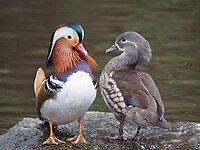
Photo from wikipedia
The rhodophyte Gracilaria chilensis is a structuring species of the estuarine and fjord systems in southern Chile and is commercially exploited from natural and farmed populations. Due to its capacity… Click to show full abstract
The rhodophyte Gracilaria chilensis is a structuring species of the estuarine and fjord systems in southern Chile and is commercially exploited from natural and farmed populations. Due to its capacity to tolerate extreme variations in environmental conditions, this species is an excellent model organism to examine stress tolerance mechanisms. The present study examined the combined effect of temperature and UV radiation on the reproductive phases of G. chilensis (carposporophyte, tetrasporophyte, and vegetative) at the lower and upper intertidals of the Valdivia River estuary. The concentration of phenolic compounds and their antioxidant capacity as well as the inhibition of primary photochemical reactions, measured as the fluorescence of photosystem II, was determined. The kinetics of the maximal quantum yield (Fv/Fm) between 5 and 50 °C indicated a rapid decrease of photosynthesis from 35 °C upwards in the three reproductive phases. Exposures for 1, 6, 24, and 48 h to photosythetically active radiation (PAR) and PAR + UV at 5, 25, and 35 °C affected photosynthesis in the three reproductive phases, especially at the elevated temperature of 35 °C where the maximum cumulative decreases of Fv/Fm were close to 93 and 98% in tetrasporophytes and carposporophytes. An important finding was the high content of phenols, which increased with increasing UV doses only at 10 °C, especially in carposporophytic and vegetative thalli. The antioxidant activity increased at 10 and 25 °C in algae exposed to UV radiation, while at low (5 °C) and elevated (35 °C) temperatures, it resulted in the inhibition of antioxidant activity. Overall, phenols were positively correlated with the antioxidant activity and Fv/Fm, especially in tetrasporophytes. The study revealed that the different life history phases of G. chilensis showed similar stress tolerance mechanisms, which appeared to be triggered strongly by temperature and less by UV radiation.
Journal Title: Journal of Applied Phycology
Year Published: 2017
Link to full text (if available)
Share on Social Media: Sign Up to like & get
recommendations!